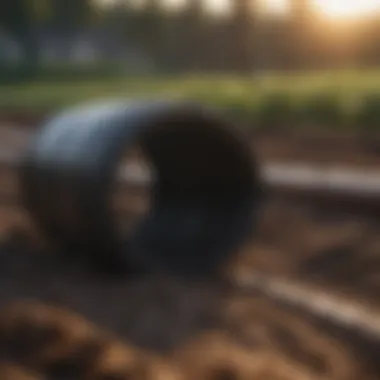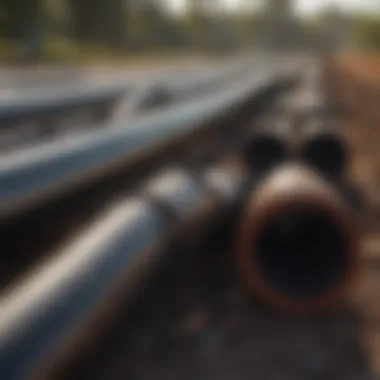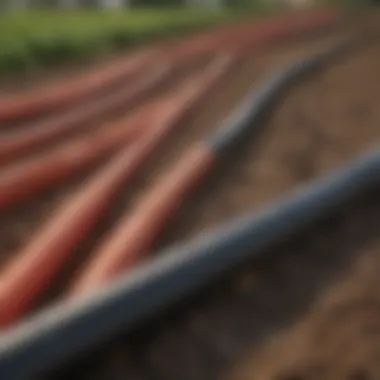Exploring 3 Inch HDPE Pipe Rolls in Modern Agriculture


Intro
The integration of advanced materials in agriculture has transformed farming practices in significant ways. One such innovation is the 3-inch High-Density Polyethylene (HDPE) pipe rolls. These have gained notable traction due to their multiple benefits in irrigation and water management. Understanding how these pipes function and their role in modern agriculture can provide farmers with the tools necessary to enhance their operations. This article will explore the unique properties of 3-inch HDPE pipe rolls, their applications, and the techniques that optimize their use in sustainable farming.
Topic Overview
Definition and Importance
High-Density Polyethylene (HDPE) is a type of plastic known for its strength and resistance to chemical corrosion. The 3-inch HDPE pipe rolls are particularly designed for transport and installation convenience in agriculture. Their versatility makes them suitable for various applications, from irrigation systems to drainage solutions. The significance of these pipes is underscored by their ability to improve water efficiency and reduce wastage, playing a crucial role in sustainable farming practices.
Brief History and Evolution
HDPE was first developed in the 1950s, primarily for packaging and containers. Over time, agricultural applications emerged as the material’s durability and flexibility became apparent. The evolution included the production of pipe rolls, which simplified the transportation and installation processes. Today, 3-inch HDPE pipe rolls are widely used in agriculture, marking a shift towards more efficient irrigation systems.
Key Techniques and Innovations
Sustainable Farming Practices
Utilizing 3-inch HDPE pipe rolls aligns with sustainable farming goals. These pipes facilitate efficient water distribution, reducing the environmental footprint. Advanced irrigation techniques, such as drip irrigation, optimize water usage, helping to conserve this precious resource. This contributes to better crop yields without excess water consumption.
Advanced Agronomic Technologies
Modern agriculture increasingly relies on technology for improvement. The integration of HDPE pipes with smart irrigation systems is a prime example. These systems monitor soil moisture and weather patterns, adjusting water supply as needed. This level of precision reduces waste and enhances crop resilience.
Practical Applications
Step-by-Step Guides
- Planning the Layout: Before installation, assess the land and decide where the pipes will be laid. Take into account the crop layout and natural water flow.
- Preparing the Soil: Clear the area where the pipes will be installed. Remove debris and loosen the soil to facilitate easy placement.
- Installing the Pipes: Unroll the HDPE pipe and cut it to the desired length. Connect it with appropriate fittings and secure them tightly.
- Testing the System: Once installed, run water through the pipes to identify any leaks or issues. Ensure that water is evenly distributed and adjust as necessary.
- Maintaining the System: Regularly inspect the pipes for wear and tear. Cleaning and checking for clogs will help maintain efficiency.
Case Studies or Real-World Examples
In California, farmers have implemented 3-inch HDPE pipe rolls in their drip irrigation systems. These installations have led to a 30% reduction in water use while maintaining crop yields. Another example is in the Midwest, where farmers report increased planting efficiency and reduced soil erosion due to better water management practices facilitated by HDPE pipes.
"The integration of 3-inch HDPE pipes has revolutionized the way we approach irrigation systems, yielding both environmental and economic benefits."
Intro to HDPE Pipe Technology
The introduction of HDPE pipe technology marks a significant advancement in agricultural practices. HDPE, or High-Density Polyethylene, is a thermoplastic made from petroleum. The adoption of this material in pipe production has transformed various agri-related applications. This section will explore the definition and historical development of HDPE pipes, illustrating their crucial role in modern farming.
Definition of HDPE
High-Density Polyethylene is known for its strength-to-density ratio. It is lightweight yet robust, making it suitable for transporting liquids and gases. HDPE is resistant to impact, possession a high tensile strength that withstands environmental stresses. This material is also impermeable, meaning it does not allow water or other substances to pass through. Moreover, it does not corrode, unlike some metal pipes, enhancing its longevity in diverse agricultural settings.
Historical Development of HDPE Pipes
The roots of HDPE pipes trace back to the early 1950s when the material was first synthesized. Over the decades, advancements in manufacturing technology have improved the reliability and performance of HDPE pipes. Initially, they were primarily used in gas and water distribution. However, by the late 20th century, agricultural applications began to gain traction, particularly in irrigation and drainage systems. Farmers recognized the advantages of lightweight, flexible pipes that could be installed quickly and easily. Today, HDPE pipes are recognized as a staple in modern agriculture, contributing significantly to water management and efficiency.
The development of HDPE pipes represents a pivotal shift in how farmers approach irrigation and water transport, increasing both productivity and sustainability in the process.
Characteristics of Inch HDPE Pipe Rolls
The characteristics of 3 inch HDPE pipe rolls are crucial in understanding their role in agricultural applications. These characteristics define how effectively they serve various purposes, ranging from irrigation systems to drainage solutions. With unique properties, these pipes not only facilitate efficient water management but also promote sustainability in farming practices.
Durability and Lifespan


The durability of 3 inch HDPE pipes is one of their strongest attributes. Unlike traditional materials like metal or concrete, HDPE pipes are designed to endure harsh conditions such as extreme temperatures and physical stress. They can withstand significant pressure without cracking or breaking, which is essential for agricultural tasks. Farmers can expect a lifespan of over 50 years, making them a wise long-term investment.
A notable aspect of durability is resistance to corrosion. HDPE does not rust or corrode, ensuring that maintenance is minimal. This quality is particularly beneficial in farming environments where moisture and chemicals are prevalent. Therefore, the long lifespan coupled with low maintenance requirements results in cost savings and reliability for farmers.
Flexibility and Installation Ease
Flexibility is another important characteristic of 3 inch HDPE pipe rolls. This property allows pipes to be bent without losing integrity. As a result, farmers can adapt the pipe layout to varying field contours without difficulty. This flexibility simplifies installation, especially in irregular terrains where straight pipe sections may not be feasible.
The installation process itself is straightforward. HDPE pipes are lightweight, making transport and handling easier compared to heavier alternatives. The ability to use fusion welding for joining sections enhances leak-free connections. In summary, this ease of installation can significantly reduce labor costs and installation time for agricultural projects.
Resistance to Chemicals and UV Light
3 inch HDPE pipes exhibit impressive resistance to chemicals and UV light, essential factors in agricultural applications. Many fertilizers and pesticides can be corrosive, but HDPE shows minimal reaction to these substances. This resistance extends the lifespan of the pipes while ensuring the integrity of the water supply remains intact.
Moreover, these pipes are designed to withstand UV radiation, which is vital given that agricultural pipes are often exposed to sunlight. The material is formulated to prevent degradation, which can lead to brittle structures over time. Thus, farmers do not need to worry about frequent replacements due to environmental exposure.
Applications in Agriculture
The applications of 3-inch HDPE pipe rolls in agriculture are significant. These pipes serve vital functions such as irrigation, drainage, and water transport. Understanding how they function in these areas can help farmers make informed decisions.
Irrigation Systems
Irrigation is essential for maximizing crop yields, especially in areas where rainfall is inadequate. 3-inch HDPE pipes are used extensively in various irrigation systems. They provide an efficient method for delivering water directly to the roots of plants. Their durability ensures they can withstand the pressure often required in pressurized systems. This durability translates into reliability for farmers.
Moreover, the flexibility of HDPE pipes makes installation easier in uneven terrains. Farmers can shape the pipes to fit the contours of their fields, reducing the need for costly and time-consuming excavation. Additionally, using HDPE reduces water loss due to its smooth interior surface, minimizing friction losses. Effective water application leads to better crop growth and higher productivity.
Drainage Solutions
Effective drainage is crucial in agriculture to prevent waterlogging, which can harm crops. 3-inch HDPE pipes are favored for their ability to efficiently drain excess water from fields. They can be installed horizontally or vertically, depending on the specific drainage needs of a property.
These pipes are resistant to corrosion and biological growth, which can plague traditional drainage systems. Furthermore, they tend to last longer compared to concrete or metal drains. This longevity reduces maintenance costs and minimizes the frequency of replacements, which can otherwise disrupt farming activities.
Water Transport and Distribution
Water transport is one of the critical functions of 3-inch HDPE pipes in agriculture. They are used to move water from various sources, such as wells, rivers, or reservoirs, to fields. The strength of HDPE pipes allows them to handle high water pressure without failure.
In addition, HDPE is lightweight. This quality simplifies the handling and installation processes. Farmers can quickly lay long stretches of these pipes, further facilitating efficient distribution.
The ease of connectivity and adaptability to various systems means farmers can expand their operation when needed. As agricultural practices evolve, 3-inch HDPE pipe rolls provide a versatile solution for water management, enhancing overall efficiency.
"3-inch HDPE pipe rolls offer farmers a combination of efficiency and reliability essential for modern agricultural practices."
Advantages Over Traditional Materials
The advantages of using 3-inch HDPE pipe rolls over traditional materials are pivotal for modern agricultural practices. Farmers and agricultural professionals are continuously seeking more efficient, cost-effective, and sustainable solutions to improve productivity. Traditional materials, such as metal or clay pipes, often present various limitations. In contrast, HDPE pipes offer multiple benefits that can enhance farming operations.
Cost-Effectiveness
One of the most compelling aspects of 3-inch HDPE pipes is their cost-effectiveness. The initial cost of HDPE material might be slightly higher than some traditional options. However, its longevity and reduced maintenance requirements can lead to significant savings over time.
- Lower Installation Costs: HDPE pipes are lightweight, making them easier to transport and install. This reduces labor costs and equipment needs.
- Durability: These pipes resist corrosion and damage from environmental factors. This durability translates to a longer lifespan, meaning farmers spend less on replacements.
- Energy Efficiency: Because HDPE has a smooth interior surface, it requires less energy to move water through the pipes. This efficiency can decrease overall operation costs, particularly in large-scale irrigation projects.
Environmental Benefits
HDPE pipes align closely with the growing emphasis on sustainability in agriculture. Their production and use present several environmental benefits:
- Recyclable Material: HDPE is fully recyclable, helping to reduce waste in landfills. This encourages farmers to adopt recycling practices not only for pipes but for other plastic materials too.
- Reduced Water Loss: With proper installation, 3-inch HDPE pipes minimize leaks. By ensuring more water reaches crops, they support efficient water management, which is crucial in regions prone to drought.
- Less Chemical Leaching: Unlike metallic pipes that may leach chemicals into the water supply, HDPE does not alter water quality, maintaining the integrity of agricultural inputs.


"The shift towards using HDPE pipes in agriculture not only enhances productivity but also supports environmental stewardship."
Long-Term Investment in Infrastructure
Investing in 3-inch HDPE pipe rolls represents a long-term vision for infrastructure in agriculture. Farmers thinking beyond immediate needs often find these pipes beneficial:
- Future-Proofing: As agricultural practices evolve, the flexibility and adaptability of HDPE pipes allow them to accommodate new technologies and methods in farming.
- Resilience to Climate Change: With climate variability, the demand for reliable water systems is paramount. HDPE pipes perform effectively in various environmental conditions, helping farmers adapt to changing climates.
- Increased Property Value: Enhanced irrigation and drainage systems using HDPE can increase the overall value of agricultural land. This investment pays off over time, especially if famers consider resale or expansion.
Each of these advantages underlines the transition necessary in agriculture. Emphasizing cost-effectiveness, environmental responsibility, and infrastructure investment reflects the realities faced by modern farmers. Therefore, embracing 3-inch HDPE pipes is more than adopting new technology; it is about making informed decisions that can impact the agricultural landscape.
Installation Techniques
The installation of 3-inch HDPE pipe rolls is a task that requires careful planning and execution. Proper installation techniques ensure optimal performance and longevity of the pipes, which is vital for effective agricultural practices. Understanding these techniques allows users to address potential challenges and achieve better results.
Site Preparation and Planning
Effective site preparation is the foundation of a successful HDPE pipe installation. Before any physical work begins, it is crucial to assess the installation area. This involves physical inspection of the land to identify any obstacles, such as rocks, existing structures, or vegetation that may obstruct the installation process.
- Soil Analysis: Understanding the soil type and its compaction level can guide decisions about trenching and pipe laying.
- Elevation & Slope: Assessing elevation can prevent water pooling and ensure efficient drainage. Proper slope assists in water flow, minimizing the risk of blockages.
- Mapping: It’s helpful to create a detailed map of where the pipes will be laid. This map should include the location of water sources, and outlets, and the planned path of the pipe, which helps in visualizing the installation process and necessary lengths.
Planning also encompasses selecting the right equipment. Trenchers, shovels, and compaction tools can enhance the installation speed and efficacy, reducing the chances of mistakes during the process. Pre-installation checks are essential to verify that all components and tools are available and in good condition.
Joining Techniques and Tools
Joining 3-inch HDPE pipes properly is critical to the integrity of the system. Incorrectly joined pipes can lead to leaks or system failures. Here are some common techniques:
- Heat Fusion: This is one of the most reliable methods for joining HDPE pipes. The process involves melting the ends of two pipe sections with heat. When joined, they cool to form a strong bond. This technique is effective for both butt fusion and socket fusion methods.
- Electrofusion: A more advanced method involves using special electrofusion fittings. This method requires an electrofusion machine that uses electrical resistance to join the pipes. It is precise and offers strong joints.
- Mechanical Fittings: While not as common for large scale applications, mechanical fittings can be useful, especially in repair situations. They allow for pipe connections without heating.
Key tools needed for these techniques include:
- Fusion Machines: Required for either heat fusion or electrofusion.
- Pipe Cutters: Essential for cutting pipes to the desired lengths.
- Alignment Tools: These instruments help ensure proper alignment during the joining process, promoting a secure bond.
Proper joining techniques optimize system leak-free performance and assure a long lifespan of HDPE installations.
Ensuring that you have the correct installation techniques and tools makes a significant difference in the results and reliability of your agricultural water management system.
Maintenance Practices
Maintenance practices are crucial for ensuring the longevity and operational efficiency of 3-inch HDPE pipes in agricultural applications. Proper maintenance significantly reduces the likelihood of failures and mitigates potential loss in productivity. Given the critical role that water management plays in agriculture, understanding maintenance practices becomes not just beneficial but necessary.
Regular Inspection Protocols
Regular inspections are part of a proactive maintenance strategy for HDPE pipes. Farmers should schedule inspections at least twice a year, ideally during the transition between growing seasons. This ensures any issues are identified early. The main focus during inspections should include:
- Visual Checks: Look for any signs of physical damage, such as cracks or deformations in the pipe.
- Leak Detection: Pay attention to wet spots or changes in soil moisture that could indicate leaks in the system.
- Connection Integrity: Ensure that all fittings, joints, and seals are secure and functioning as intended.
- Soil Erosion: Assess the area around the pipes for any signs of soil erosion that may expose or damage the pipes over time.
Implementing a checklist can make this process more efficient and systematic, reducing the risk of oversight. Post-inspection, it is important to document findings to track the condition of the pipes over time.
Repair and Replacement Guidelines
Despite best efforts, occasional repairs or replacements are inevitable in any irrigation system. Knowing when and how to conduct these repairs is essential. Here are some guidelines:
- Assessing Damage: If significant cracks or holes are found during inspections, they must be repaired immediately. Consider the pipe's age and the extent of damage when making a decision about repair vs. replacement.
- Repair Techniques: Smaller leaks can usually be sealed using specialized HDPE repair kits or tapes. For more extensive damage, sections of pipe might need replacing. Use compatible materials to maintain integrity.
- Replacement Protocol: When a section needs replacement, first identify and mark the affected segment. Excavate carefully to avoid causing further damage to surrounding infrastructure. Replace with new HDPE pipe, ensuring that it meets the original specifications.
- Post-Repair Testing: After repairs or replacements, conduct a pressure test to verify that the system is sealed effectively. Any remaining issues should be addressed before resuming normal operations.
Following these guidelines not only extends the life of the HDPE system but also ensures a more reliable water management strategy for farming operations. This commitment to maintenance ultimately supports the goals of sustainable agriculture, promoting efficient water use for enhanced crop production.


"A proactive approach to maintenance guarantees that your irrigation system remains effective and efficient."
By understanding and implementing thorough maintenance practices, agricultural professionals can harness the full potential of 3-inch HDPE pipe rolls, leading to more sustainable and productive farming.
Challenges and Considerations
In the realm of agricultural practices, the implementation of 3-inch HDPE pipe rolls is not without its difficulties. While these pipes offer numerous benefits, understanding their challenges is equally crucial for effective utilization. This section addresses key elements that can impact the performance and reliability of HDPE pipes in farming environments.
Potential Sources of Damage
HDPE pipes are known for their durability, however, they are not immune to damage. Identifying potential sources of damage is essential for any farmer using these pipes. Here are some common issues that can arise:
- Physical impacts: Heavy machinery and equipment can inadvertently create punctures or bends in the pipes.
- Burrowing animals: Rodents and other burrowing animals may chew or create holes in the pipes, leading to leaks.
- Extreme weather conditions: Severe temperatures, such as excessive heat or frost, can weaken the material and lead to fractures.
- Improper installation: If pipes are installed with incorrect techniques, unnecessary stress may lead to damage over time.
To mitigate these risks, farmers should ensure proper placement and consider protective measures such as covering pipes with soil or using protective barriers. Regular inspections can also help identify problems early.
Regulatory Compliance Issues
Navigating regulatory compliance is pivotal for farmers using HDPE pipes. Various local, state, and national regulations govern the use of materials in agriculture. Compliance may involve:
- Water usage regulations: Farmers must adhere to restrictions regarding water usage and efficient distribution. These regulations can dictate the type of pipe that can be used.
- Environmental impact assessments: Some regions may require assessments to ensure that the installation of HDPE systems does not disrupt local ecosystems.
- Quality standards: Ensuring that the materials meet specified safety and quality standards is paramount and often mandated by law.
Failure to comply with these regulations can result in fines and disruptions to farming operations. Therefore, it is essential for farmers to maintain updated knowledge of relevant regulations and to work closely with local authorities to ensure compliance.
Ensuring effective management of both potential damages and regulatory requirements fosters a sustainable approach to the use of 3-inch HDPE pipe rolls.
Sustainability and Future Prospects
Sustainability is becoming increasingly crucial in today's agricultural practices. As farmers face challenges related to water shortages, changing climate, and a growing global population, the adoption of 3-inch HDPE pipe rolls offers a significant pathway toward sustainable agriculture. These pipes not only facilitate efficient water management but also contribute to broader environmental objectives.
Role in Sustainable Agriculture
The role of 3-inch HDPE pipe rolls in sustainable agriculture is multifaceted. First, they enhance water conservation efforts. By providing precise irrigation solutions, these pipes minimize water waste. This efficiency is vital in areas experiencing drought or limited water resources.
Through the use of HDPE pipes, farmers can implement drip irrigation systems. These systems deliver water directly to the plant roots, thus reducing evaporation and runoff. This targeted approach allows for the optimization of crop yields while using significantly less water. Furthermore, the resistance of HDPE pipes to corrosion and biological growth ensures clean water delivery throughout the growing season.
Another important aspect is the contribution of these pipes to soil health. By reducing over-irrigation, HDPE systems help prevent soil erosion and degradation. Maintaining soil structure leads to better crop productivity and sustainability.
Innovations in HDPE Technology
Advancements in HDPE technology are continually improving its effectiveness in agricultural applications. Recent innovations focus on enhancing durability while preserving flexibility, key attributes for maintaining functionality in diverse agricultural environments.
For instance, the integration of smart technologies in HDPE pipe systems allows for real-time monitoring of water flow and pressure. This data helps farmers make informed decisions about irrigation, thereby improving overall management efficiency.
Moreover, manufacturers are experimenting with different additives to improve HDPE’s UV resistance and longevity. Innovations such as biodegradable additives have emerged, which can enhance the environmental compatibility of these pipes.
"The advancements in HDPE technology signify a clear direction towards more sustainable practices in agriculture, making them essential for the future."
Epilogue
The importance of understanding the role of 3-inch HDPE pipe rolls in agriculture cannot be overstated. As farming practices evolve, so too must the tools and technologies employed to optimize efficiency and productivity. This article emphasizes the multifaceted benefits of HDPE pipes, their application in various farming processes, and the significance of proper installation and maintenance.
Summary of Key Points
In summary, the core themes discussed include:
- The durability and flexibility of HDPE pipes that allow for adaptable use in various agricultural scenarios.
- Their critical applications such as in irrigation systems, drainage solutions, and water distribution, which are essential for modern farming.
- The advantages over traditional materials in terms of cost-effectiveness and environmental impact.
- Techniques that ensure successful installation and ongoing maintenance to maximize lifespan and performance.
- Challenges such as potential damage and compliance issues that must be considered in practical implementations.
These points illustrate how crucial HDPE pipes are in promoting sustainable agricultural practices and efficient water management.
Final Thoughts on Adoption
Adopting 3-inch HDPE pipe rolls is more than a technical decision; it is a strategic move towards enhancing agricultural efficiency. Farmers must weigh the benefits against the challenges and embrace innovative approaches. By implementing these advanced pipe systems, agricultural operations can achieve greater sustainability and productivity in their water management practices. With the ongoing advancements in HDPE technology, the future of agricultural water management looks promising, reinforcing the importance of these tools for both current and future farming scenarios.



